Are you tired of seeing the same old birds in your backyard every day? Want to add some new feathered friends to your bird-watching list?
Look no further! In this article, we will introduce you to 14 types of small brown birds that are commonly found in North America.
From the mischievous Brown-headed Cowbird to the charming Song Sparrow, these birds may be small in size, but they certainly pack a punch in terms of personality and beauty.
So, grab your binoculars and get ready to explore the amazing world of small brown birds.
| Image | Bird | Features | Price |
|---|---|---|---|
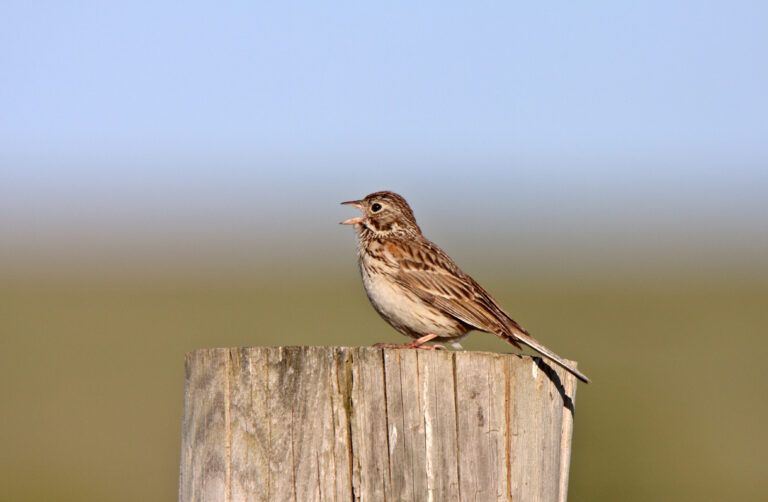 |
| 9.7 | Check Price |
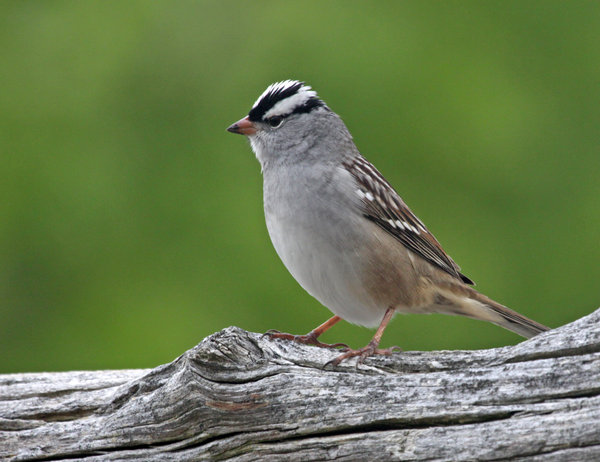 |
| 9.5 | Check Price |
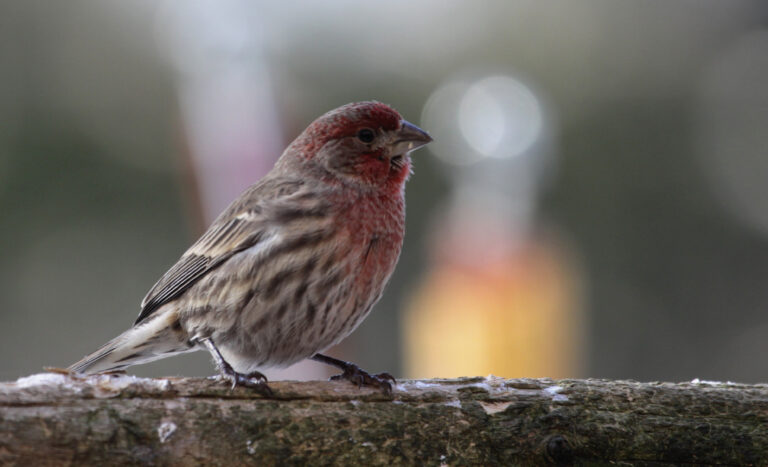 |
| 9.1 | Check Price |
 |
| 8.8 | Check Price |
 |
| 8.6 | Check Price |
 |
| 8.2 | Check Price |
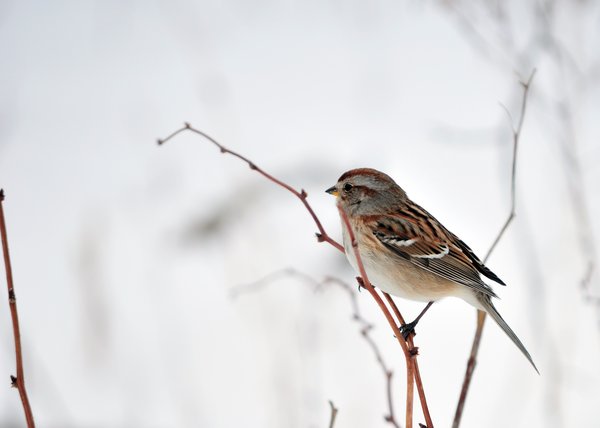 |
| 8 | Check Price |
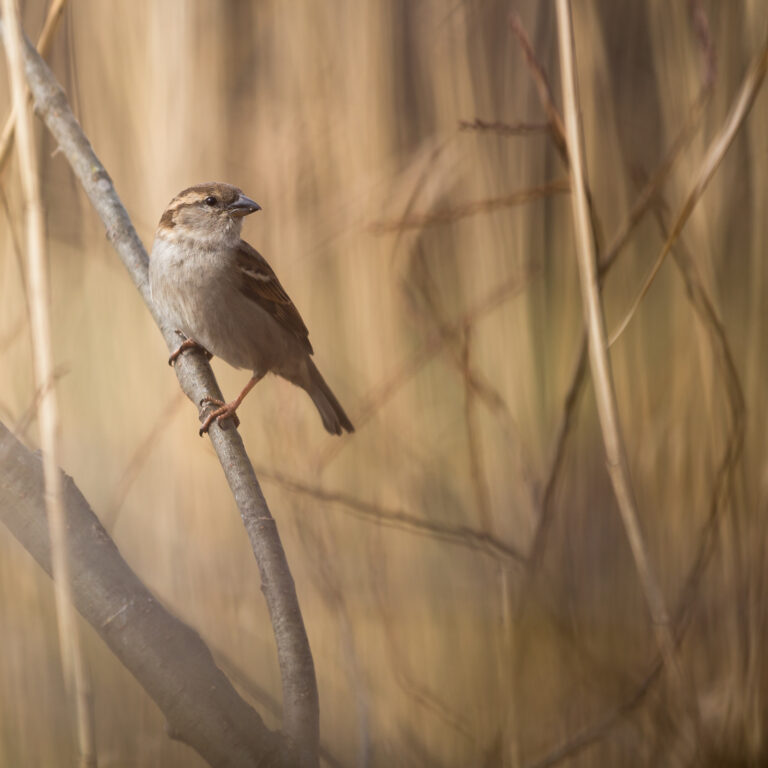 |
| 7.7 | Check Price |
 |
| 7.4 | Check Price |
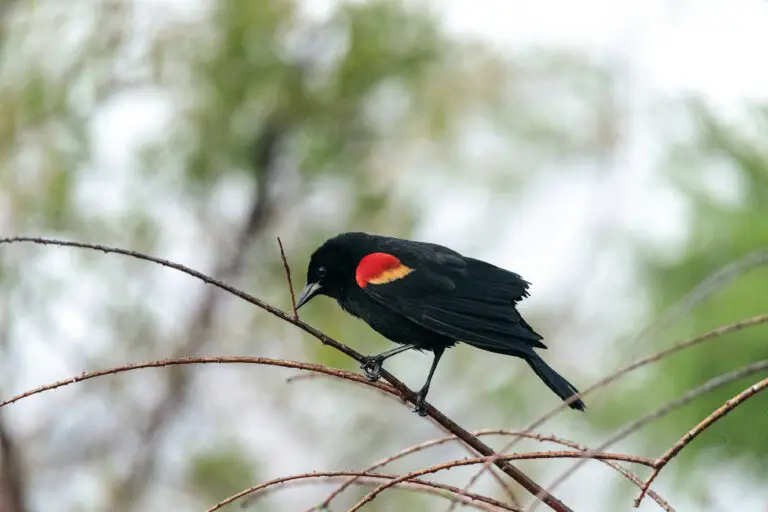 |
| 7.2 | Check Price |
 |
| 9.5 | Check Price |
 |
| 9.5 | Check Price |
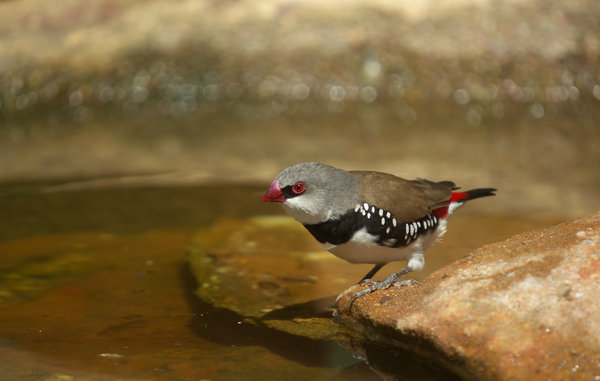 |
| 9.5 | Check Price |
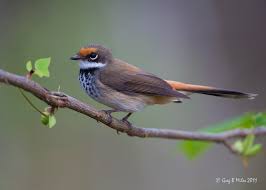 |
| 9.5 | Check Price |
If you don’t have the time to read the whole article, check out this video for a quick understanding.
Types of Small Brown Birds in North America
1. Song Sparrow
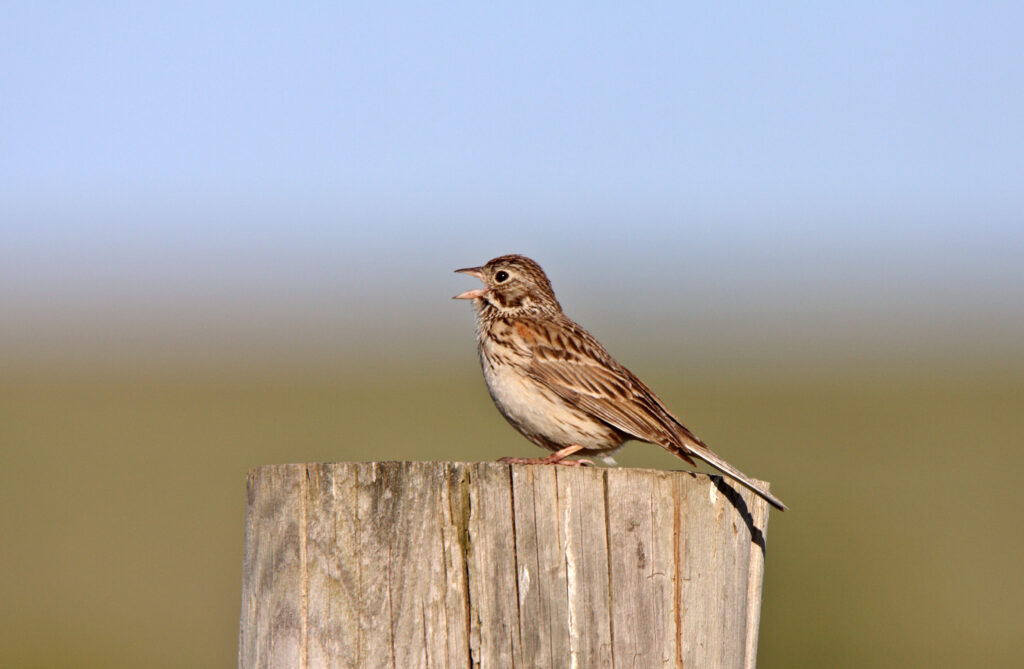
The Song Sparrow (Melospiza melodia) is a small bird commonly found in North America.
Song Sparrow can be found in coastal Alaska and the United States mid-latitudes.
Migratory species breed in the north, winter in the south, and migrate north into Mexico.
Song Sparrows prefer moist, shady environments.
They can be found in marshes and backyards with huge bushes and hedges. Under bushes in gardens, hop on the ground.
They do not form flocks in damp marshy areas, yet they can be abundant.
These sparrows have rounded tails and modest sizes.
The length of a Song Sparrow is approximately 16 cm, with a weight of around 18-25 g.
Their wingspan is approximately 22-27 cm.
Its size and coloring vary greatly across its range.
Some birds are light in color, while others are dark in color. With a pale brow line, the face is rather grey.
A black line runs from the eye to the back of the head.
A broad black stripe runs down the side of the white neck.
The heavy streaking on the sides blends into a patch in the middle of the breast.
A chimp call is the most prevalent sound.
The musical melody begins with a few small notes, a louder drawn-out buzz, and a final loose, jumbled trill (sung for much of the year, although not in the middle of winter).
Usually found on the ground under the feeder or seeking food under shrubs, hops around a lot in large platform feeders.
Song sparrows consume the smaller seeds and fruit from your feeder.
They switch to largely insect matter in the summer and may not visit your feeder.
Below are the characteristics of the Song Sparrow,
| Scientific Name | Melospiza melodia |
| Family Name | Emberizidae |
| Length | 5.5 to 6.7 inches (14 to 17 cm) |
| Weight | 0.7 to 1.4 ounces (20 to 40 g) |
| Wingspan | 7.9 to 9.8 inches (20 to 25 cm) |
| Habitat | forests, fields, wetlands, and suburban areas |
| Food | seeds, insects, spiders, and other small invertebrates |
2. White-crowned Sparrow

The White-crowned Sparrow (Zonotrichia leucophrys) is a small bird native to North America.
White-crowned Sparrow Breed in Alaska and the western mountains as well as the Pacific Northwest lowlands and coastal California.
Winter extends from the lower portion of the United States to Mexico.
White-crowned Sparrows are approximately 15-18 cm in length, with a weight of around 20-30 g.
Their wingspan is around 25-30 cm.
There are about five different types, each with a somewhat different song and plumage.
The type found around the coast of California does not migrate.
Wintering White-crowned Sparrows forage on roadsides and lawns in dense brushy roadside tangles.
White-crowned sparrows were hopping out of cover farther and farther till disturbed and scurrying back into the undergrowth to resume feeding.
These birds have larger and slightly longer sparrows with long tails.
Brown striped back and wing on a grey body. Adults have a crown with a distinctive black and white striped pattern. Bill is yellow or pinkish in color.
Immature’ crown stripes are replaced with buff and rufous in their first year, making them look a little dingier.
White-crowned Sparrows may be somewhat more likely to attend feeders in the West than in the East.
They used feeders having a tray, such as a platform or hopper feeders.
Their primary meals are millet and black oil sunflower seeds.
Below are the characteristics of the White-crowned Sparrow,
| Scientific Name | Zonotrichia leucophrys |
| Family Name | Emberizidae |
| Length | 6.3 to 7.1 inches (16 to 18 cm) |
| Weight | 1.0 to 1.5 ounces (30 to 42 g) |
| Wingspan | 9.4 to 10.6 inches (24 to 27 cm) |
| Habitat | forests, fields, wetlands, and suburban areas |
| Food | seeds, insects, spiders, and other small invertebrates |
3. House Finch
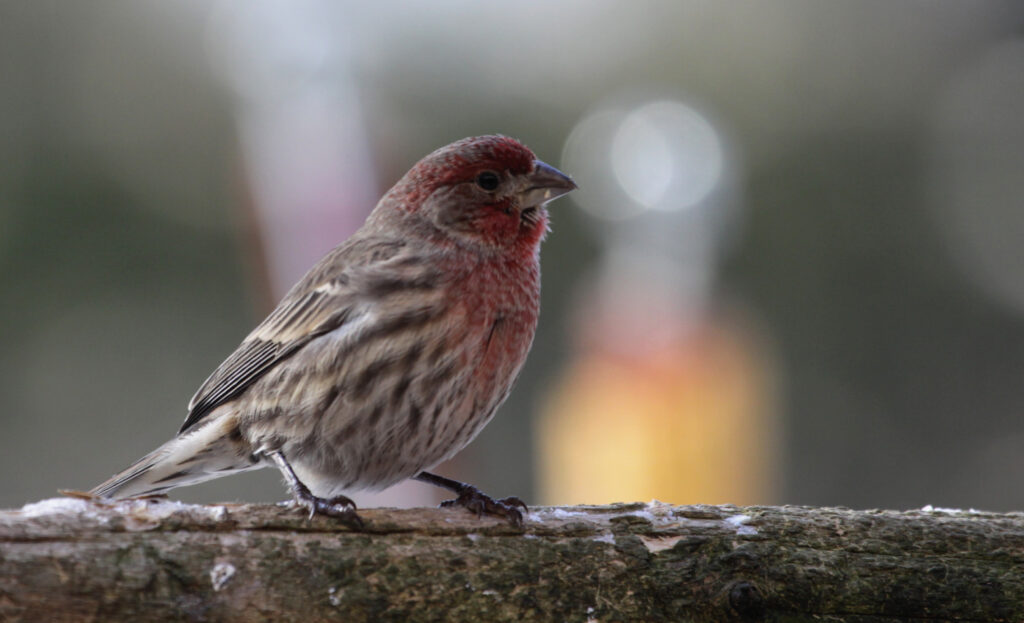
The House Finch (Haemorhous mexicanus) is a small bird native to North America.
From southern Canada to Mexico, these birds can be found. Ranches and residential areas are where you’ll find it.
Lowlands with brushy woods and openings are also present. Flocking and swooping down.
These birds frequently perch in the summits of scrubby trees.
When startled, they fly up into the trees rather than down into the bushes, as most sparrows do. Nest in the vicinity of structures.
This is the small brown bird that is most likely to visit your feeder.
House Finches are approximately 12-15 cm in length, with a weight of around 15-20 g.
Their wingspan is around 20-25 cm.
These birds have a little brown bird with highly streaked underbelly in both sexes, with a small head and a thin build.
Short wings and a long, slender tail with a slight notch near the end.
The brightest red is found on the forehead and rump of adult males. Males’ red color might vary from orange to yellowish depending on the individual.
In tube feeders, House Finches love hulled sunflowers and black oil sunflower seeds.
Male Cassin’s and Purple Finch males have pink or purple underpants that aren’t stripped, but male House Finch males have brown streaked sides.
The head and face of female House Finches are relatively simple and unmarked.
The other two birds’ light brows and lower faces curl over the brown ear covertly.
Below are the characteristics of the House Finch,
| Scientific Name | Haemorhous mexicanus |
| Family Name | Fringillidae |
| Length | 5.5 to 6.3 inches (14 to 16 cm) |
| Weight | 0.6 to 1.0 ounces (17 to 28 g) |
| Wingspan | 8.7 to 9.8 inches (22 to 25 cm) |
| Habitat | forests, fields, wetlands, and suburban areas |
| Food | seeds, insects, and other small invertebrates. They also feed on fruits, berries, and nectar |
4. Brown-headed Cowbird

The Brown-headed Cowbird (Molothrus ater) is a small bird native to North America.
Breeds south of the Arctic Circle in North America (unusual in Alaska).
In the winter, birds migrate out of Canada and the inner West.
Brown-headed Cowbirds are approximately 17-22 cm in length, with a weight of around 30-40 g.
Their wingspan is around 30-35 cm.
Brown-headed Cowbirds may be found in open fragmented forests, scattered pasturelands, and residential areas.
They spend the winter months on feedlots and meadows.
During the winter, Brewer’s Blackbird flocks may cluster in strip mall parking lots.
Birds moving north are more likely to visit backyard bird feeders in the spring.
The male display comprises raising the head to the sky and fanning the wings and tail.
Cowbirds lay eggs in the nests of smaller birds, who care for the young as if they were their own.
These birds have a tiny blackbird with a potbellied appearance, a neck, and a short tail.
These Sparrows have a flat head and a short, conical beak.
Male Cowbirds have a brown head and a glossy black coat with green iridescence.
Immature birds have a paler appearance and streaky underbelly.
These delicate juvenile birds molt in the fall, revealing startlingly black patches of feathers.
Their diet consists mainly of insects, seeds, and grains.
Below are the characteristics of the Brown-headed Cowbird,
| Scientific Name | Molothrus ater |
| Family Name | Icteridae |
| Length | 7.5 to 9.0 inches (19 to 23 cm) |
| Weight | 1.1 to 1.8 ounces (30 to 50 g) |
| Wingspan | 11.8 to 13.0 inches (30 to 33 cm) |
| Habitat | forests, fields, wetlands, and suburban areas |
| Food | seeds, insects, and other small invertebrates |
5. Golden-crowned Sparrow

The golden-crowned sparrow (Zonotrichia atricapilla) is a species of sparrow native to North America.
The Breeding of these birds ranges from Alaska to British Columbia’s highlands.
Winter is mostly spent along the West Coast, south to Baja, and in the interior of the West, near the Mexican border.
Golden-crowned Sparrows like brushy environments at the edges of woods, where they congregate in large flocks.
They are hopping forage on the ground. When danger is detected, they flee for cover.
When compared to White-crowned Sparrows, this species is bigger.
These birds have plump and long-tailed, with a huge head and a broad beak, a filthy gray-brown with deeper brown stripes on the back and wings, very dreary and drab.
The golden-crowned sparrow measures approximately 7.5 inches (19 cm) in length.
The average weight of the golden-crowned sparrow is 1.2 ounces (34 g).
The wingspan of the golden-crowned sparrow measures approximately 10.5 inches (27 cm).
Adults have a golden yellow head with black lateral crown stripes in breeding plumage. Immature has a bright yellow forehead and crown streaked with brown, as well as diffuse brown lateral crown stripes.
In the winter, adults exhibit head patterns and plumage that is halfway between breeding adult and juvenile plumage.
Golden-crowned Sparrows eat from trays in platform and hopper feeders.
The golden-crowned sparrow’s diet mainly consists of seeds and insects. During the winter, it also feeds on fruit and berries.
Below are the characteristics of the Golden-crowned Sparrow,
| Scientific Name | Zonotrichia atricapilla |
| Family Name | Emberizidae |
| Length | 6.3 to 7.1 inches (16 to 18 cm) |
| Weight | 1.1 to 1.5 ounces (32 to 43 g) |
| Wingspan | 8.7 to 9.8 inches (22 to 25 cm) |
| Habitat | forests, fields, wetlands, and suburban areas |
| Food | seeds, insects, spiders, and other small invertebrates. They also feed on fruits, berries, and nectar |
6. White-throated Sparrow

The white-throated sparrow (Zonotrichia albicollis) is a species of sparrow native to North America.
These raptor’s Breeding ranges from northern Canada to the Midwest and the Northeastern United States.
They migrate from the Northeast and Southwest of the United States in the winter.
In the West, it’s unusual to see it in the winter.
The white-throated sparrow measures approximately 6 inches (15 cm) in length.
The average weight of the white-throated sparrow is 0.7 ounces (20 g).
The wingspan of the white-throated sparrow measures approximately 9 inches (23 cm).
White-throated Sparrows prefer coniferous and mixed woods to raise their young.
They like thick forests and edge habitats in the winter, especially if there are bird feeders nearby.
It’s common to see big flocks of birds. Hop on the ground in openings near the cover to feed.
Sing all winter and make repeated calls at dawn and dark.
Adults might have black and white striped heads or brown and white striped heads.
For their first year, immature birds have a mottled appearance with brown and white striped heads.
These birds have bright white necks with dark grey sides and grey or brown upper breasts.
White-throated Sparrows have a brilliant yellow patch on the forehead between the beak and the eye.
The white-throated sparrow’s diet consists mainly of seeds and insects.
During the breeding season, it also feeds on spiders and snails.
The sparrow forages on the ground and in low vegetation.
Below are the characteristics of the White-throated Sparrow,
| Scientific Name | Zonotrichia albicollis |
| Family Name | Emberizidae |
| Length | 6.3 to 7.1 inches (16 to 18 cm) |
| Weight | 1.1 to 1.5 ounces (32 to 43 g) |
| Wingspan | 7.1 to 8.7 inches (18 to 22 cm) |
| Habitat | forests, fields, wetlands, and suburban areas |
| Food | seeds, insects, spiders, and other small invertebrates. They also feed on fruits, berries, and nectar |
7. American Tree Sparrow

The American Tree Sparrow’s scientific name is Spizella arborea.
These are the birds’ breeds on the shrubby tundra, winters in the northern two-thirds of the United States.
The American Tree Sparrow measures approximately 5.5 inches in length. On average, the American Tree Sparrow weighs around 0.6 ounces (18 g).
The wingspan of the American Tree Sparrow ranges from 6.3 to 6.7 inches (16-17 cm).
Tree Sparrows like grassy or weedy environments near trees in the winter. Feeding them the ground is a good idea.
These birds are frequently seen in groups. Occasionally, they will mingle with other sparrows.
The back and wings of this little grey bird are brown, while the tail is a deeper grey color. The head is round, while the tail is squared.
The head is light grey in color, with a rufous crown and a line running back from the eye. On the breast, there is a black patch.
The wing bars are white. The music is a pure, beautiful warble that descends. The sound is that of a gentle tweedle dee.
American Tree Sparrows primarily feed on seeds, but also consume insects and other invertebrates.
Below are the characteristics of the American Tree Sparrow,
| Scientific Name | Spizelloides arborea |
| Family Name | Passerellidae |
| Length | 5.5 to 6.3 inches (14 to 16 cm) |
| Weight | 0.7 to 1.0 ounces (20 to 28 g) |
| Wingspan | 7.1 to 8.7 inches (18 to 22 cm) |
| Habitat | forests, fields, wetlands, and tundra |
| Food | seeds, insects, spiders, and other small invertebrates |
8. House Sparrow
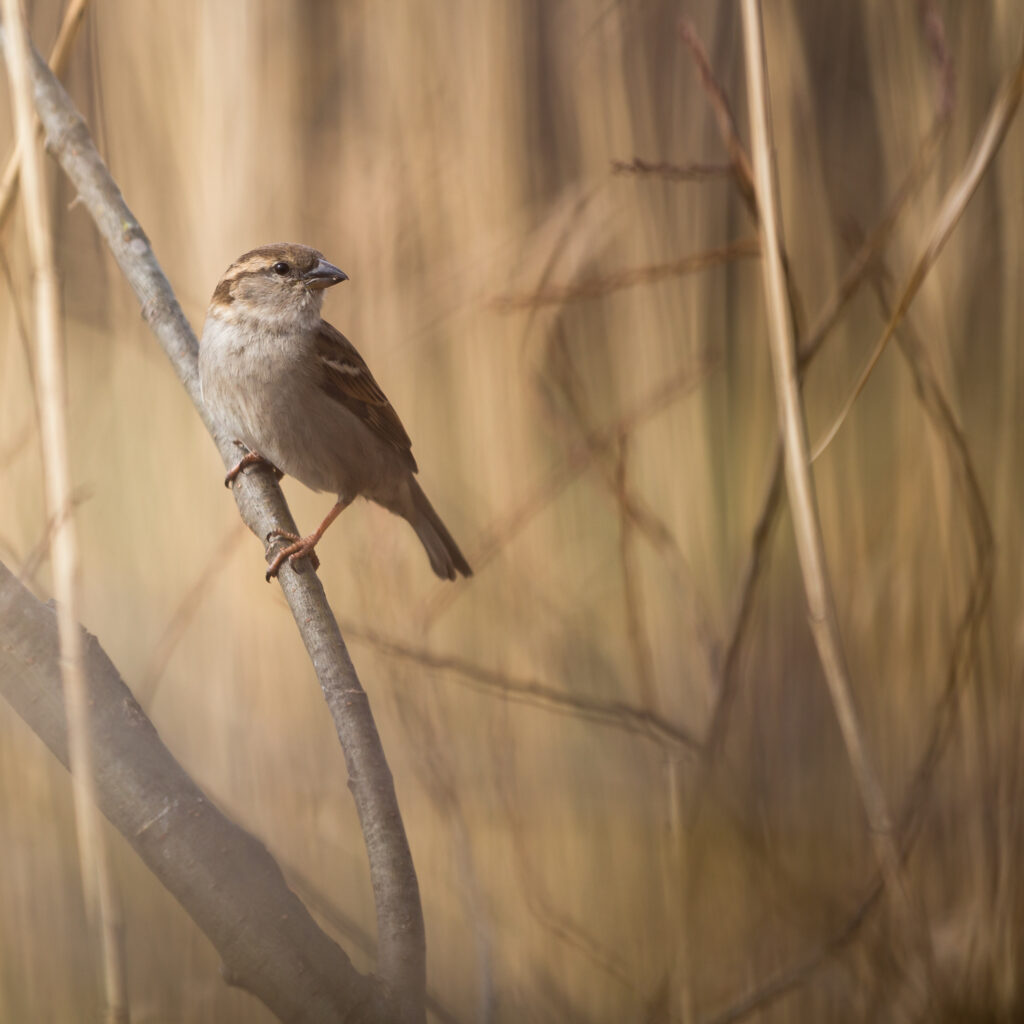
House Sparrows were brought from Europe in the mid-1800s and are now found throughout North America, from mid-latitudes in Canada south through Mexico. They don’t move in any way.
House Sparrows may be found in towns, farms, horse stables, strip malls, and urban areas.
House Sparrows follow humans everywhere they go.
They make their nests in nooks and crevices in buildings, street lights, barns, and nest boxes. House Sparrows congregate in loud flocks.
The House Bird is a small sparrow.
They have large bodies and small legs. Their necks are short, and their skulls are flat, with nothing in the way of a forehead hump.
The body, rump, and tail of males in breeding plumage are grey.
The wings are dark with chestnut tones and a single broad white wing bar with a single broad white wing bar.
Males have a tiny black mask and chin in all plumages, and the black throat reaches to the breast in breeding plumage.
From below the eye to the neck and back, the crown is grey and chestnut.
Females and young birds are a drab gray-brown color with a darker back and wings.
The underbelly and rump are greys once more. A broad pale brow can be seen behind the eye.
Although House Sparrows have flimsy feet, they prefer to eat from the ground or from trays on platforms and hopper feeders.
Small seeds are consumed by House Sparrows. White proso millet is their preferred bird food. Canary seed and German millet are two more foods that they enjoy.
Below are the characteristics of the House Sparrow,
| Scientific Name | Passer domesticus |
| Family Name | Passeridae |
| Length | 5.5 to 6.3 inches (14 to 16 cm) |
| Weight | 0.7 to 1.0 ounces (20 to 28 g) |
| Wingspan | 7.1 to 8.7 inches (18 to 22 cm) |
| Habitat | forests, fields, wetlands, and urban areas |
| Food | seeds, insects, spiders, and other small invertebrates |
9. Bewick’s Wren

The House Sparrow (Passer domesticus) is a small passerine bird that is widely distributed throughout the world.
These birds are year-round inhabitants of the Pacific Coast, the southern interior of the West, Texas, and Mexico.
They’re not prevalent in the Mississippi and Ohio River Valleys.
House Sparrows typically measure 14-16 cm (5.5-6.3 in) in length. The average weight of a House Sparrow is 24-39 g (0.8-1.4 oz).
The wingspan of a House Sparrow ranges from 25-29 cm (9.8-11.4 in).
Chaparral, desert scrub, rainforest clearings, riverbank tangles, and backyard hedges are examples of brushy woods in a range of biomes.
In search of bug meal, crawls and jumps through low tangled foliage, bush, and abandoned constructions.
Bewick’s Wren is smaller than the majority of sparrows.
The physique is round and chubby. Neck less. Bill is long, slender, and slightly curved.
The long floppy tail was frequently pulled up over the back. White brow stripe that runs the length of the brow. Parts of the body are grey. The back and wings are brownish, ranging from reddish-brown to grayer in color.
These birds have a loud song with single notes and trills, frequently a buzzy sound, comparable to a Song Sparrow. Individual birds have a variety of songs.
The House Sparrow primarily feeds on seeds and grains, but it also eats insects, fruit, and nectar.
Below are the characteristics of the Bewick’s Wren,
| Scientific Name | Thryomanes bewickii |
| Family Name | Troglodytidae |
| Length | 4.3 to 4.7 inches (11 to 12 cm) |
| Weight | 0.4 to 0.5 ounces (12 to 14 g) |
| Wingspan | 5.9 to 6.7 inches (15 to 17 cm) |
| Habitat | forests, woodlands, chaparral, and suburban areas |
| Food | insects, spiders, and other small invertebrates |
10. Red-winged Blackbird
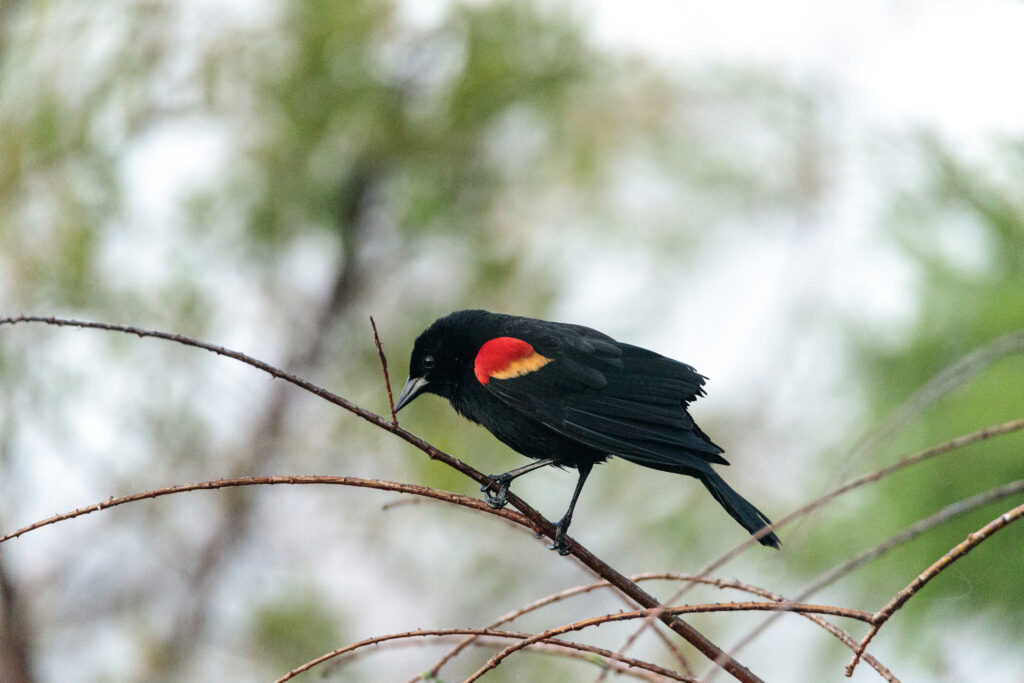
The Red-winged Blackbird (Agelaius phoeniceus) is a passerine bird found in North America.
These birds are throughout the United States and Mexico year-round residents and are breeders throughout Alaska and Canada during the summer.
In the winter, these northern birds move south to join other permanent birds.
They make nests in damp meadows and cattail marshes.
Red-winged Blackbirds spend the winter in the same environment as they do during the mating season, but they often congregate in large groups in feedlots and grain fields.
The length of a Red-winged Blackbird ranges from 25-28 cm (9.8-11 in). The average weight of a Red-winged Blackbird is 46-65 g (1.6-2.3 oz).
The wingspan of a Red-winged Blackbird is approximately 40-50 cm (16-20 in).
Gender may be used to divide winter flocks.
Males perch prominently in the spring. Females like to hide among marsh plants or grasses. Forage on the ground often.
They have Stocky with short tails and potbellied bellies. Straight, conical, and sharp-pointed bill, it’s bigger than a sparrow.
Males have a reddish-orange shoulder with a yellow line. Females are strongly streaked, or striped reddish-brown, buffy white, grey, and black, and novice bird observers sometimes mistake them for sparrows.
The neck is frequently pinkish-orange in color. Immature males are identical to mature males, except they have some red on their shoulders.
Red-winged Blackbirds eat the majority of bird seed. They also consume suet. Because they are bigger, they prefer to eat from the platform feeders first.
Below are the characteristics of the Red-winged Blackbird,
| Scientific Name | Agelaius phoeniceus |
| Family Name | Icteridae |
| Length | 7.5 to 9.1 inches (19 to 23 cm) |
| Weight | 1.0 to 1.5 ounces (28 to 43 g) |
| Wingspan | 12.6 to 14.2 inches (32 to 36 cm) |
| Habitat | marshes, swamps, fields, and wetlands |
| Food | insects, spiders, and other small invertebrates |
11. Fox Sparrow

The Fox Sparrow (Passerella iliaca) is a medium-sized sparrow that is native to North America.
These birds breed in the Rocky Highlands and throughout northern Canada’s mountains.
They can be seen on the West Coast and in the Southeast throughout the winter.
Scrubby environments are where you’ll find Fox Sparrows. This includes brushy openings in alpine and boreal woods in the summer.
During the winter, thick tangles can be observed in the chaparral.
They remain concealed for a while, but they finally respond to pishing. After all other birds have lost interest, Fox Sparrows may remain perched in the open.
The Fox Sparrow measures approximately 6.7 inches (17 cm) in length. The Fox Sparrow has a weight of approximately 1.6 ounces (45 g).
The Fox Sparrow has a wingspan of about 10.6 inches (27 cm).
The majority of their eating time is spent on the ground or in low-growing bushes.
They are towhee-sized sparrows with a big stocky bodies. There are a lot of regional variances.
There might be three to four species rather than simply one.
Birds in coastal Alaska and British Columbia are dark sooty brown with heavily streaked breasts.
Gray-headed birds with large beaks can be seen in the California highlands.
The Rocky Mountain birds have a grey head and a short break.
The birds of the East and north are light grey with brilliant foxy orange striping.
Above, the hue is a solid brown with reddish tones on the rump and wings. Below is heavily streaked, with several big spots and narrow inverted chevrons.
Fox Sparrows typically forage on the ground, kicking over leaf litter behind thick shrubs.
The Fox Sparrow feeds on seeds, insects, and berries, using its large bill to crack open hard seeds.
In the winter, it feeds on buds, bark, and fruits.
Below are the characteristics of the Fox Sparrow,
| Scientific Name | Passerella iliaca |
| Family Name | Passerellidae |
| Length | 7.1 to 7.5 inches (18 to 19 cm) |
| Weight | 1.1 to 1.8 ounces (31 to 51 g) |
| Wingspan | 11.0 to 11.8 inches (28 to 30 cm) |
| Habitat | forests, woodlands, and thickets |
| Food | insects, spiders, and other small invertebrates |
12. Female Purple Finch

The Female Purple Finch (Haemorhous purpureus) is a species of finch native to North America.
These birds are bred in the southern United States and Canada.
They are Year-round residents of Southeast Alaska and the United States west coast up to southern California.
Winters are more common in the East than in the West, except where residents live.
They can be found in Forests of cool, wet conifers.
In the winter, lowland woods and residential areas are particularly attractive. It likes to forage amid the tree branches.
The Female Purple Finch measures approximately 5.5 inches (14 cm) in length. The Female Purple Finch has a weight of approximately 1 ounce (28 g).
The Female Purple Finch has a wingspan of about 9.4 inches (24 cm).
Males can be heard singing from the tops of trees. It’s common to see flocks of them. During the winter, it visits bird feeders.
They have Plump big angled heads and huge bills. The tail is short and sharply notched.
The female Purple Finch’s underbelly is extensively streaked.
The back and wings are tinged with a greenish hue. Face with a lot of patterns.
The pale broad brow encircles the black ear covertly and returns to the lower face.
Males have unblemished breasts and sides. Even over the brown wings and back, the upper parts were tinted with crimson.
Purple Finches love black oil seeds over other seeds. Their primary feeding method is tube feeders.
Below are the characteristics of the Female Purple Finch,
| Scientific Name | Haemorhous purpureus |
| Family Name | Fringillidae |
| Length | 5.5 to 6.3 inches (14 to 16 cm) |
| Weight | 0.7 to 1.0 ounces (20 to 28 g) |
| Wingspan | 9.8 to 11.0 inches (25 to 28 cm) |
| Habitat | woodlands, forests, and suburban areas |
| Food | insects, spiders, and other small invertebrates |
13. Diamond Firetail

The Diamond Firetail (Stagonopleura guttata) is a species of finch native to Australia.
Their vivid red tail feathers and white speckled flanks distinguish them and make them easy to detect.
Female Firetails are not the typical drab brown of most female birds; instead, they are the same color as the males.
They nest among thorny shrubs and bushes to shield their eggs and young from predators in open grassland forests, heath, and farmland in south-eastern Australia.
The Diamond Firetail measures approximately 5 inches (13 cm) in length. The Diamond Firetail has a weight of approximately 0.7 ounces (20 g).
The Diamond Firetail has a wingspan of about 7.9 inches (20 cm).
The Rufous Fantail has a weight of approximately 0.4 ounces (11 g).
The Rufous Fantail has a wingspan of about 7.1 inches (18 cm).
Firetails eat seeds and fruits that are ripe or half-ripe. They also eat insects and bug larvae on a regular basis.
Firetails hunt for food on the ground and will bounce about rather than fly.
The male Firetail does not sing; instead, he creates a low-pitched buzzing sound, which is most noticeable during the courting ritual.
He draws attention to himself by swaying up and down with dry grass in his beak until she notices him and then opens his lips as if asking for food.
She enjoys it so much that she’s decided to move in with him.
Firetails are monogamous. They begin breeding at the age of nine months, and the timing is determined by the temperature; they will not breed if the weather is too hot or cold.
Diamond Firetails prefer an open environment; however, they have been spotted in cities.
They usually feed in couples or small groups of four or five.
The Diamond Firetail feeds on seeds, insects, and spiders.
It feeds on seeds from grasses, shrubs, and trees, and also feeds on insects and spiders, which provide a good source of protein for nesting and rearing young.
Below are the characteristics of the Diamond Firetail,
| Scientific Name | Stagonopleura guttata |
| Family Name | Estrildidae |
| Length | 5.1 to 5.9 inches (13 to 15 cm) |
| Weight | 0.5 to 0.7 ounces (14 to 20 g) |
| Wingspan | 7.1 to 8.7 inches (18 to 22 cm) |
| Habitat | open woodlands and grasslands |
| Food | small seeds and insects |
14. Rufous Fantail

The Rufous Fantail is species found throughout Australia’s northern and eastern coasts.
In March, adult Rufous Fantails in southern Australia almost finished their journey north.
Younger Rufous Fantails will be following them in March and April.
During migration, they typically visit more open environments, such as our gardens and parks.
The Rufous Fantail measures approximately 4.3 inches (11 cm) in length. The Rufous Fantail has a weight of approximately 0.4 ounces (11 g).
The Rufous Fantail has a wingspan of about 7.1 inches (18 cm).
The Rufous Fantail is identified by its rufous or reddy-brown head, back, and tail feathers, as well as its fanned tail, which is roughly twice as long as its body.
Unlike many other bird species, the female Rufous Fantail has just as brilliantly colored plumage as the male but is slightly smaller. People can make the Rufous Fantail nervous.
It is a fast-flying bird that, like its relatives the Grey Fantail and Willie Wagtail, flits from place to place and hides among leaves.
If you remain motionless and wait silently for a while, it may forget its fear and approach you.
The Rufous Fantail stays low to the ground when eating.
The Rufous Fantail feeds on insects, spiders, and other small invertebrates.
Look for them performing acrobatics in the air while catching flying insects or skipping between tempting heaps of leaf litter.
While searching for food, they continually fan their tails and flap their wings and bodies.
Below are the characteristics of the Rufous Fantail,
| Scientific Name | Rhipidura rufifrons |
| Family Name | Rhipiduridae |
| Length | 5.1 to 5.9 inches (13 to 15 cm) |
| Weight | 0.7 to 0.9 ounces (20 to 25 g) |
| Wingspan | 7.5 to 9.1 inches (19 to 23 cm) |
| Habitat | forests, woodlands, and gardens |
| Food | small insects |
Conclusion
In conclusion, small brown birds are a diverse and abundant group of birds found all over the world.
From the Fox Sparrow to the elusive and striking House Finch, these birds come in different shapes, sizes, and habitats.
Again, These are the Types of Small Brown Birds:
- Song Sparrow
- White-crowned Sparrow
- House Finch
- Brown-headed Cowbird
- Golden-crowned Sparrow
- White-throated Sparrow
- American Tree Sparrow
- House Sparrow
- Bewick’s Wren
- Red-winged Blackbird
- Fox Sparrow
- Female Purple Finch
- Diamond Firetail
- Rufous Fantail
With their unique features, behaviors, and songs, these birds play an important role in their ecosystem and bring joy and beauty to our lives.
Whether you are an avid birdwatcher or simply appreciate the birds in your backyard, taking the time to learn about these 14 different types of small brown birds is sure to be a rewarding experience.
FAQ
What are the most common types of small brown birds?
Some of the most common types of small brown birds include the House Sparrow, American Tree Sparrow, Song Sparrow, Chipping Sparrow, Field Sparrow, and Junco.
How can I identify small brown birds?
You can identify small brown birds by their size, color, markings, songs, and behavior. It is also helpful to observe their habitat, migration patterns, and diet.
Are small brown birds all found in North America?
No, small brown birds can be found all over the world, although some species may be more abundant in certain regions.
What is the difference between a sparrow and a finch?
Sparrows and finches are both types of small brown birds, but they belong to different families. Sparrows are passerine birds belonging to the family Passeridae, while finches are passerine birds belonging to the family Fringillidae. The main difference between the two is the shape of their beak, with finches having a more conical beak adapted for cracking seeds.
Are small brown birds important to the environment?
Yes, small brown birds play important roles in their ecosystem by pollinating plants, dispersing seeds, and controlling insect populations. They also provide food for predators and are important indicators of habitat health.
Last Updated on March 22, 2023 by Lily Aldrin
